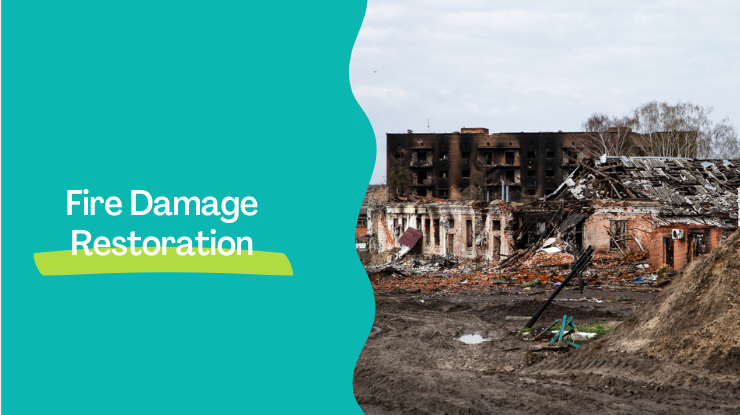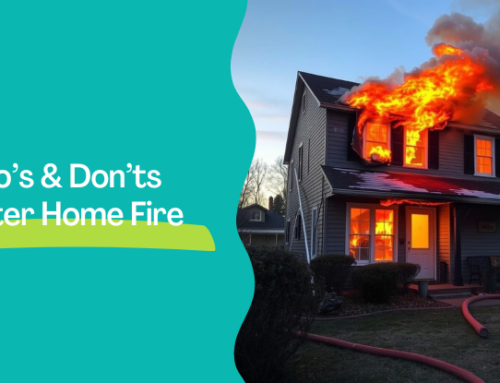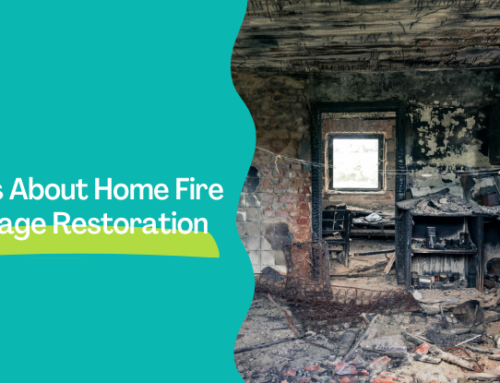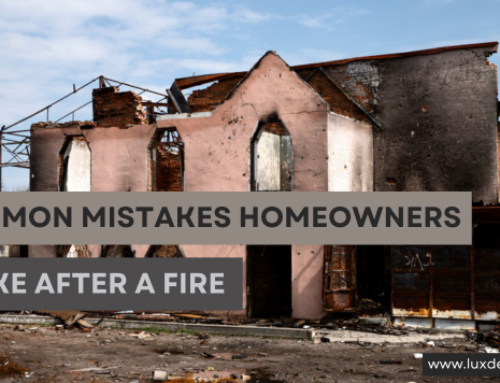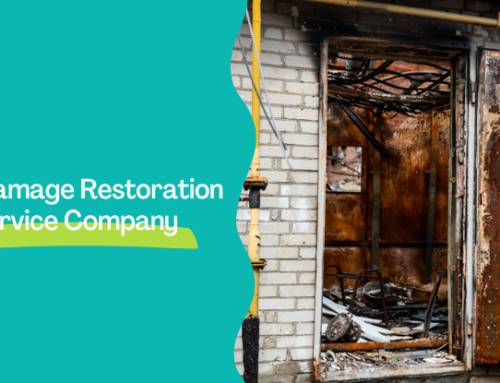Experiencing a fire is life-altering, often leaving behind more than just physical damage—it also impacts emotional well-being. Whether it’s a small kitchen fire or a large structural blaze, fire damage restoration is critical for making your property safe, functional, and livable again.
This guide provides an in-depth look at the fire damage restoration process, offering valuable insights to help you confidently navigate this challenging time. From understanding the process to learning the key steps, here’s everything you need to know.
Contents
- What is Fire Damage Restoration?
- The Importance of Fire Damage Restoration
- Steps in Fire Damage Restoration
- Initial Assessment and Inspection
- Emergency Mitigation and Property Securing
- Soot and Smoke Removal
- Odor Elimination
- Water Damage Restoration
- Structural Repairs and Reconstruction
- Content Cleaning and Restoration
- Final Walkthrough and Quality Assurance
- Hire LUX Construction Group!
- Advanced Fire Restoration Technology and Tools
What is Fire Damage Restoration?
Fire damage restoration is the process of cleaning, repairing, and restoring a property after it has been damaged by fire, smoke, and water used to extinguish the flames. The objective is to return the property to its pre-loss condition while addressing safety and health concerns.
The Importance of Fire Damage Restoration
Fires don’t just burn materials; they weaken structures, contaminate air quality, and leave behind residues that can cause long-term damage. Here’s why fire damage restoration is crucial:
- Ensures Structural Stability: Fires can compromise walls, floors, and roofs, making them unsafe.
- Prevents Secondary Damage: Water from firefighting efforts can lead to mold and structural decay if not addressed quickly.
- Improves Air Quality: Smoke and soot residues pose health risks and need to be thoroughly cleaned.
- Supports Insurance Claims: Restoration professionals document damages, streamlining the claims process for homeowners.
Professional fire damage restoration isn’t just about repairs; it’s about safeguarding your property and health.
Steps in Fire Damage Restoration
Here’s a breakdown of the steps involved in the fire damage restoration process.
-
Initial Assessment and Inspection
The fire damage restoration process begins with a comprehensive property assessment to determine the full extent of the damage, as fire can affect hidden areas. The restoration team inspects the property to identify damage caused by fire, smoke, soot, and water.
Tools like thermal imaging cameras help detect heat damage behind walls, ceilings, and floors, while moisture meters find water in hidden spaces. This initial assessment is crucial for understanding the damage and planning the restoration. A damage report is created to assist with insurance claims and ensure all affected areas are addressed.
-
Emergency Mitigation and Property Securing
Once the initial assessment is complete, the next step is to prevent further damage and secure the property. Immediate action is crucial to protect against additional harm from weather or unauthorized access.
Emergency mitigation services, like board-up services, cover broken windows, doors, and exposed areas, preventing rain, wind, or trespassing. If the roof is damaged, tarping is applied to shield exposed sections from water. These measures help stabilize the property and prevent additional damage before restoration begins.
-
Soot and Smoke Removal
After securing the property, removing soot and smoke residues is the next crucial step. Soot particles can be complex to remove, but if left untreated, they can cause lasting damage to surfaces and air quality.
The restoration team uses specialized cleaning agents to scrub walls, ceilings, and floors, breaking down stubborn soot stains for easier removal. HEPA vacuums are then employed to capture remaining smoke particles, improving indoor air quality. This thorough soot removal reduces the risk of respiratory issues and helps restore the property to a safe, clean state.
-
Odor Elimination
One of the most persistent issues after a fire is the lingering smoke odor that can penetrate carpets, furniture, and fabrics. Specialized deodorization techniques are used to eliminate these odors.
Ozone generators neutralize smoke odors at a molecular level by attaching to smoke particles and preventing them from re-emitting. Additionally, thermal foggers treat hard-to-reach areas, creating a deodorizing fog that penetrates deep into porous materials. Together, these methods restore air quality and remove the unpleasant smoke smell, leaving a fresh, clean environment.
-
Water Damage Restoration
Water damage often accompanies fire damage due to the water used to extinguish the flames. This moisture can lead to mold growth and further structural issues if left untreated. The restoration team begins by removing standing water with powerful pumps and vacuums.
After the water is extracted, industrial-grade dehumidifiers and air movers are used to dry the space quickly. Moisture meters are also used to ensure all affected areas, including walls, floors, and ceilings, are fully dry, preventing mold growth and safeguarding the property’s structure.
-
Structural Repairs and Reconstruction
Once the property is dry and free of water, soot, and odors, the next step is repairing and rebuilding the structural components. Fire can cause extensive damage to walls, ceilings, floors, and even the foundation. Depending on the severity, some parts may need to be replaced.
The restoration team will repair or replace damaged drywall, flooring, and ceilings to restore the property. If needed, the team will also handle major reconstruction, including roof repairs, insulation installation, and foundation work. This stage is crucial for restoring both the property’s appearance and safety.
-
Content Cleaning and Restoration
Fire damage affects the property’s structure and can harm personal belongings such as furniture, electronics, and documents. Restoring these items is an essential part of the fire damage restoration process. The restoration team works to clean and deodorize furniture and personal items that may have been affected by smoke and soot.
Specialized cleaning methods are used for electronics, ensuring they are restored to working condition and protected from further damage. In addition, essential documents such as photographs, papers, and books are carefully cleaned and restored. If needed, these items are securely stored off-site during the restoration process to ensure their safety. This step helps ensure that as much of your property as possible is salvaged and restored to its pre-fire condition.
-
Final Walkthrough and Quality Assurance
The final step ensures the restoration work meets quality standards. A walkthrough with the client allows them to review the completed job and address any concerns.
Post-restoration inspections confirm the property is clean, safe, and free from odors or hidden damage. A comprehensive report offers peace of mind and a record of the restoration process.
Hire LUX Construction Group!
Restoring a fire-damaged property requires expertise, precision, and attention to detail. Each step in the process—assessment, cleaning, drying, and reconstruction—plays a vital role in returning the property to its pre-fire condition.
When fire damage strikes, having the right professionals can make all the difference. LUX Construction Group provides comprehensive fire damage restoration services, combining experience, advanced tools, and a commitment to quality.
Advanced Fire Restoration Technology and Tools
Restoring fire-damaged properties requires cutting-edge tools and technology for effective results. Here’s what we use to ensure a thorough restoration:
- Thermal Imaging Cameras: Detect hidden damage behind walls and ceilings without invasive inspections.
- HEPA Air Scrubbers: Remove airborne soot and allergens to improve indoor air quality.
- Industrial-Grade Dehumidifiers: Eliminate moisture from firefighting efforts to prevent mold growth.
- Ozone Generators: Neutralize lingering smoke odors at a molecular level.
- Thermal Foggers: Reach deep into furniture and carpets to remove embedded smoke odors.
- Moisture Meters: Monitor moisture levels to ensure complete drying.
- Eco-Friendly Cleaning Agents: Safely restore surfaces affected by soot and smoke.
These advanced tools allow us to restore your property efficiently while prioritizing safety and quality. With our help, you can restore your property efficiently and regain peace of mind.

